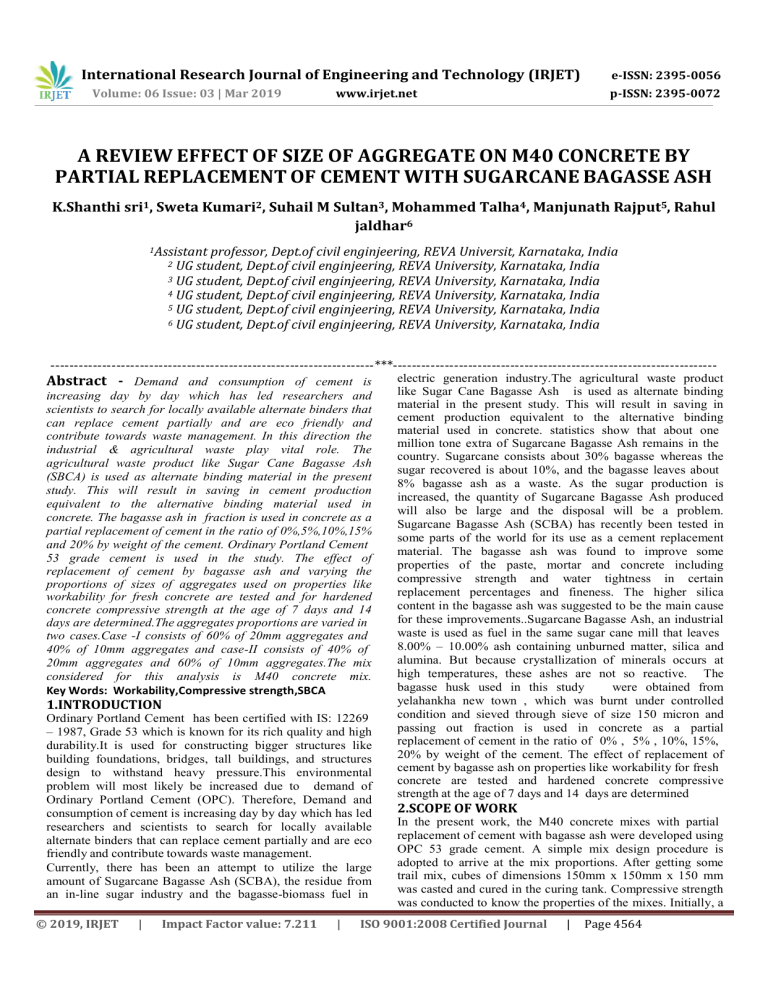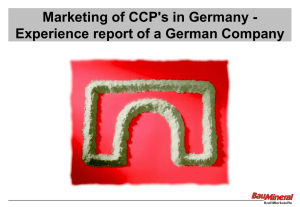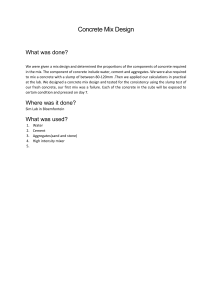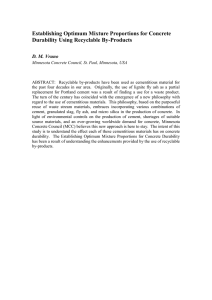Aggregate Size & SBCA Effect on M40 Concrete
advertisement

International Research Journal of Engineering and Technology (IRJET) Volume: 06 Issue: 03 | Mar 2019 www.irjet.net e-ISSN: 2395-0056 p-ISSN: 2395-0072 A REVIEW EFFECT OF SIZE OF AGGREGATE ON M40 CONCRETE BY PARTIAL REPLACEMENT OF CEMENT WITH SUGARCANE BAGASSE ASH K.Shanthi sri1, Sweta Kumari2, Suhail M Sultan3, Mohammed Talha4, Manjunath Rajput5, Rahul jaldhar6 1Assistant professor, Dept.of civil enginjeering, REVA Universit, Karnataka, India UG student, Dept.of civil enginjeering, REVA University, Karnataka, India 3 UG student, Dept.of civil enginjeering, REVA University, Karnataka, India 4 UG student, Dept.of civil enginjeering, REVA University, Karnataka, India 5 UG student, Dept.of civil enginjeering, REVA University, Karnataka, India 6 UG student, Dept.of civil enginjeering, REVA University, Karnataka, India 2 ---------------------------------------------------------------------***--------------------------------------------------------------------- Abstract - Demand and consumption of cement is increasing day by day which has led researchers and scientists to search for locally available alternate binders that can replace cement partially and are eco friendly and contribute towards waste management. In this direction the industrial & agricultural waste play vital role. The agricultural waste product like Sugar Cane Bagasse Ash (SBCA) is used as alternate binding material in the present study. This will result in saving in cement production equivalent to the alternative binding material used in concrete. The bagasse ash in fraction is used in concrete as a partial replacement of cement in the ratio of 0%,5%,10%,15% and 20% by weight of the cement. Ordinary Portland Cement 53 grade cement is used in the study. The effect of replacement of cement by bagasse ash and varying the proportions of sizes of aggregates used on properties like workability for fresh concrete are tested and for hardened concrete compressive strength at the age of 7 days and 14 days are determined.The aggregates proportions are varied in two cases.Case -I consists of 60% of 20mm aggregates and 40% of 10mm aggregates and case-II consists of 40% of 20mm aggregates and 60% of 10mm aggregates.The mix considered for this analysis is M40 concrete mix. Key Words: Workability,Compressive strength,SBCA 1.INTRODUCTION Ordinary Portland Cement has been certified with IS: 12269 – 1987, Grade 53 which is known for its rich quality and high durability.It is used for constructing bigger structures like building foundations, bridges, tall buildings, and structures design to withstand heavy pressure.This environmental problem will most likely be increased due to demand of Ordinary Portland Cement (OPC). Therefore, Demand and consumption of cement is increasing day by day which has led researchers and scientists to search for locally available alternate binders that can replace cement partially and are eco friendly and contribute towards waste management. Currently, there has been an attempt to utilize the large amount of Sugarcane Bagasse Ash (SCBA), the residue from an in-line sugar industry and the bagasse-biomass fuel in © 2019, IRJET | Impact Factor value: 7.211 | electric generation industry.The agricultural waste product like Sugar Cane Bagasse Ash is used as alternate binding material in the present study. This will result in saving in cement production equivalent to the alternative binding material used in concrete. statistics show that about one million tone extra of Sugarcane Bagasse Ash remains in the country. Sugarcane consists about 30% bagasse whereas the sugar recovered is about 10%, and the bagasse leaves about 8% bagasse ash as a waste. As the sugar production is increased, the quantity of Sugarcane Bagasse Ash produced will also be large and the disposal will be a problem. Sugarcane Bagasse Ash (SCBA) has recently been tested in some parts of the world for its use as a cement replacement material. The bagasse ash was found to improve some properties of the paste, mortar and concrete including compressive strength and water tightness in certain replacement percentages and fineness. The higher silica content in the bagasse ash was suggested to be the main cause for these improvements..Sugarcane Bagasse Ash, an industrial waste is used as fuel in the same sugar cane mill that leaves 8.00% – 10.00% ash containing unburned matter, silica and alumina. But because crystallization of minerals occurs at high temperatures, these ashes are not so reactive. The bagasse husk used in this study were obtained from yelahankha new town , which was burnt under controlled condition and sieved through sieve of size 150 micron and passing out fraction is used in concrete as a partial replacement of cement in the ratio of 0% , 5% , 10%, 15%, 20% by weight of the cement. The effect of replacement of cement by bagasse ash on properties like workability for fresh concrete are tested and hardened concrete compressive strength at the age of 7 days and 14 days are determined 2.SCOPE OF WORK In the present work, the M40 concrete mixes with partial replacement of cement with bagasse ash were developed using OPC 53 grade cement. A simple mix design procedure is adopted to arrive at the mix proportions. After getting some trail mix, cubes of dimensions 150mm x 150mm x 150 mm was casted and cured in the curing tank. Compressive strength was conducted to know the properties of the mixes. Initially, a ISO 9001:2008 Certified Journal | Page 4564 International Research Journal of Engineering and Technology (IRJET) Volume: 06 Issue: 03 | Mar 2019 www.irjet.net sample mix design was followed and modifications were made accordingly while arriving at the trail mixes to get optimized mix which satisfies both fresh, hardened properties and the economy. 3.MATERIALS AND TEST METHODS CEMENT-OPC 53 Grade cement is required to conform to BIS specification IS:12269-1987 with a designed strength for 28 days being a minimum of 53 MPa or 530 kg/sqcm.Not only is this grade of cement stronger than other grades / types, it is also more durable. FINE AGGREGATE-In order to achieve adequate workability, the cement paste volume must be high enough to encapsulate all of the aggregate particles and to provide some workability while the concrete is fresh. The specific gravity of sand is 2.680. Those passing from 4.750 mm to 150 micron are known as fine aggregate, and the bulk density of fine aggregate (loose state) is 1393.17 kg/m3 and rodded state is 1606.85 kg/m3. COARSE AGGREGATE-The crushed aggregates used were 10mm and 20 mm nominal maximum size and are tested as per Indian standards and results are within the permissible limit. The specific gravity of coarse aggregate is 2.830; the bulk density of coarse aggregate is 1692.32 kg/m3 and rodded state is 1940.18kg/m3. SUGARCANE BAGASSE ASH-Bagasse is the dry pulpy fibrous residue that remains after sugar cane or sorghum stalks are crushed to extract their juice. It is used as a biofuel for the production of heat, energy, and electricity, and in the manufacture of pulp and building materials. Sugarcane bagasse contains of Cellulose 45–55 percent, Hemicellulose 20–25 percent, Lignin 18–24 percent and Ash 1–4 percent. WATER-The requirements of water for concreting & curing as per IS: 456-2000, after available in college campus. 4.MIXING AND CASTING The required amount of materials were weighed and the materials were spread in layers in the bottom of the pan, coarse aggregate first, followed by cement, fine aggregate and finally the sugarcane bagasse ash. The constituents of the mixes were mixed dry for 1 minute in order to homogenize the batched mix; subsequently water was added and mixed for a further 3 minutes. The concrete was cast into the moulds in three layers, and 25 blows were given to each layer, using 16 mm diameter bar, to remove any entrapped air. For each mix of varying percentages of sugarcane bagasse ash the required numbers of cubes (total of 40 cubes) were casted.Out the 40 cubes casted 20 cubes were of case-I with 60% of 20mm aggregates and 40% of 10mm aggregates and 20 cubes were of case-II with 40% of 20mm aggregates and 60% of 10mm aggregates.The moulds were covered by sacking for 24 hours © 2019, IRJET | Impact Factor value: 7.211 | e-ISSN: 2395-0056 p-ISSN: 2395-0072 at room temperature. The specimens were de-molded after at least 24 hrs and poured into the curing tank.The workability tests adopted for this investigation were the Slump Cone test and Compacting Factor test. The process of selecting suitable ingredients of concrete such as cement, sand, aggregate, water and determining their relative amounts with the objective of producing a concrete of the required, strength, durability, and workability as economically as possible, is known as the concrete mix design. The proportioning of ingredients of concrete such as cement, sand, aggregate & water is governed by the required performance of concrete in two states, namely the plastic and the hardened states. If the plastic concrete is not workable, it cannot be properly placed and compacted. The property of workability, therefore, becomes of vital importance. The compressive strength of hardened concrete which is generally considered to be an index of its other properties, depending upon many factors, for ex. Water Cement ratio quality and quantity of cement, water, aggregate, batching, placing, compaction and curing. The cost of concrete is made up of the cost of material, plant and labour. The variation in the cost of material arise from the fact that the cement is several times costly than the aggregates, thus the aim is to produce as lean a mix as possible. The actual cost of concrete is related to the cost of materials required for producing a minimum mean strength known as characteristic strength that is specified by the designer of the structure. This depends on the quality control measures, but there is no doubt that the quality control adds to the cost of concrete. On the workability of mix the cost of labour depends. 5.EXPERIMENTAL WORK In this experimental work, a total of 40 numbers of concrete specimens were casted. The standard size of cube 150.00 mm ×150.00 mm ×150.00 mm is used. The mix design of concrete was done according to Indian Standard (IS) guidelines for M40 grade for the granite stone aggregates and the water cement ratio are 0.5. Based upon the quantities of ingredient of the mixes, the quantities of Sugarcane Bagasse Ash (SCBA) for 0%, 5%, 10%, 15%, 20% & 25% replacement by weight were estimated. The ingredients of concrete such as cement, sand, aggregate & water were thoroughly mixed in tilting or non-tilting mixer machine till uniform thoroughly consistency was achieved. Before casting, machine oil was smeared on the inner surfaces of the Cast Iron (CI) mould. Concrete was poured into the mould and compacted thoroughly using table vibrator or other types of vibrators. The top surface was finished with the help of a trowel. The specimens were removed from the mould after 24.00 hrs. Then cured under water for a period of 7 and 14 days. The specimens were taken out from the curing tank or water tank just prior to the test. The tests for compressive strength were conducted using a 2000.00 kN compression testing machine, These tests were conducted as per the relevant Indian Standard (IS) specifications. ISO 9001:2008 Certified Journal | Page 4565 International Research Journal of Engineering and Technology (IRJET) Volume: 06 Issue: 03 | Mar 2019 www.irjet.net Cube specim en number Number of cubes to be tested for 7 days Numbe r of cubes to be tested for 28 days Percent age of sugarca ne bagasse ash Percen tage of 20mm aggreg ates Percen tage of 10mm aggreg ates specim en-1 2 2 0 60 40 specim en-2 2 2 5 60 40 specim en-3 2 2 10 60 40 specim en-4 2 2 15 60 40 specim en-5 2 2 20 60 40 specim en-6 2 2 0 40 60 specim en-7 2 2 5 40 60 specim en-8 2 2 10 40 60 specim en-9 2 2 15 40 60 specim en-10 2 2 20 40 60 7. CONCLUSIONS The experimental results from references show that the strength of concrete is increased with the help of Sugar Cane Bagasse Ash (SCBA).Hence the effect of size of aggregate in varying proportions of sugarcane bagasse ash is analysed in this study.The mix proportion of case-1 ie 60% of 20mm aggregates and 40% of 10mm aggregates with 10% sugarcane bagasse ash is expected to give highest compressive strength compared to all other specimen samples.The actual results and observations would be published in the upcoming journal. REFERENCES R. Srinivasan, K Sathiya, 2010. “Experimental study on bagasse ash in concrete”, Journal of Service Learning in Engineering 5(2), p. 60 [2] Ganesan, K., Rajagopal, K., &Thangavel K., 2007. “Evaluation of Bagasse Ash as Supplementary Cementitious Material”, Journal of Cement and Concrete Composites [1] Sugar cane bagasse ash (SCBA) is generated as a combustion by-product from boilers of sugar and alcohol factories. Composed mainly of silica, this by-product can be used as a mineral admixture in mortar and concrete. Several studies have shown that the use of SCBA as partial Portland cement replacement can improve some properties of cementitious materials. However, it is not yet clear if these improvements are associated to physical or chemical effects. This work investigates the pozzolanic and filler effects of a residual SCBA in mortars. Initially, the influence of particle size of SCBA on the packing density, pozzolanic activity of SCBA and compressive strength of mortars was analyzed. In addition, the behavior of SCBA was compared to that of an insoluble material of the same packing density. The results indicate that SCBA may be classified as a pozzolanic | Impact Factor value: 7.211 p-ISSN: 2395-0072 material, but its activity depends significantly on its particle size and fineness.This was due to the combined effect of relative fineness and the Pozzolonic activity of Sugarcane Baggage Ash (SCBA) and also may be due to the existing of crystalline silica (SiO2). According to Bui strengthening capability of a mineral admixture not only depends on the Pozzolonic reactivity, but also on the relative fineness of the filler material. Decrease in compressive strength values with increase in the substitution ratio indicated that filler effect was predominant only up to 10% ash substitution. The increase in compressive strength values in the sample is due to the combined effect of physical and chemical processes. Physical action was caused by the high specific surface area of Sugarcane Baggage Ash (SCBA) and chemical action was the Pozzolonic reaction between calcium hydroxide (CH) and silica (SiO2). 6.COMPRESSIVE STRENGTH DEVELOPMENT © 2019, IRJET e-ISSN: 2395-0056 | [3] Payá, J., ET. al., 2002. Sugarcane bagasse ash (SCBA): “Studies on its properties for reusing in concrete production”, Journal of Chemical technology and Biotechnology 77, p... 321. [4] N. B. Singh, V. D. Singh and SaritaRai, 2000. Hydration of Bagasse Ash-Blended Portland cement, Journal of Cement and Concrete Research 30, p. 1485. [5] SumrerngRukzon, PrinyaChindaprasirt, 2012. Utilization of Bagasse Ash in High Strength Concrete, Journal of Materials and Design 34, p. 45. [6] V. S. Aigbodion, S. B. Hassan, T. Ause and G.B. Nyior, 2010. Potential Utilization of Solid Waste (Bagasse Ash), ISO 9001:2008 Certified Journal | Page 4566 International Research Journal of Engineering and Technology (IRJET) Volume: 06 Issue: 03 | Mar 2019 www.irjet.net e-ISSN: 2395-0056 p-ISSN: 2395-0072 BIOGRAPHIES Journal of Minerals & Materials Characterization & Engineering 9, p.67-77. K.Shanthi sri Assistant professor School of civil engineering REVA university [7] Ganesan, K., Rajagopal, K., & Thangavel, K. 2007. “Evaluation of bagasse ash as supplementary cementitious material”. Cement and Concrete Composites, 29, 515-524. [8] Committee Board of sugar cane and sugar (2004). Summary of sugar cane and sugar industry in Thailand in 2003/2004, Division of sugar cane and sugar industry Policy, Ministry of Industry, Vol.2 Bangkok Thailand (in Thai). Suhail M Sultan UG Student School of civil engineering REVA university [9] Baguant,K., Properties of concrete with bagasse ash as fine aggregate, In Proc 5th CANMET/ACI Intl. conf. on fly ash, silica fume, slag and natural pozzolans in concrete, Ed by Malhotra VM, USA, ACI SP, (1995)153(18), 315-337. Sweta Kumari UG Student School of civil engineering REVA university [10] Payá, J., ET. al., Sugarcane bagasse ash (SCBA): studies on its properties for reusing in concrete production, Journal of Chemical technology and Biotechnology, (2002)77, 321-325. 6. IS 383 -1970 “Specifications for Coarse and Fine Aggregates from Natural Sources for Concrete”, Bureau of Indian Standards, New Delhi. Mohammed Talha UG Student School of civil engineering REVA university [11] IS 10262 -1981 “IS Method of Mix Design”, Bureau of Indian Standards, New Delhi [12] IS 516 -1959 “Methods of Tests for strength of concrete”, Bureau of Indian Standards, New Delhi [13] IS 456 -2000 “Code of Practice for Plain and Reinforced Concrete”, Bureau of Indian Standards, New Delhi. [14] Wang R, Trettin V, Rudert R (2003) Umlaut recrystallization of granulated blast furnace slag and the significance for the hydraulic Reactivity. [15] International Journal of Engineering Science And Management, [Bangar, 7(1): January-March 2017], ISSN 2277 – 5528. (REPLACEMENT OF CEMENT WITH BAGASSE ASH ) © 2019, IRJET | Impact Factor value: 7.211 | Manjunath Rajput UG Student School of civil engineering REVA university Rahul Jaldar UG Student School of civil engineering REVA university ISO 9001:2008 Certified Journal | Page 4567


